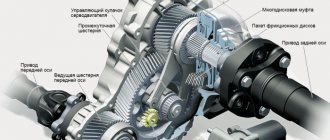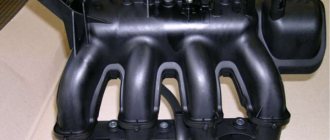Many novice drivers are interested in the question of what car restyling is, why it is needed and “what it is eaten with.” In simple terms, this concept means making changes to the appearance of the car. In Russia, many people call restyling the word “tuning”, although these terms differ in meaning. In the first case, changes are made to the interior and exterior of the car, and tuning is considered to be an improvement in the technical equipment of the car. There are other concepts that characterize making adjustments to a car in such a way that a more aggressive shape of the car appears. In this material it is worth considering the concept of restyling in more detail.
What is car restyling
Using restyling, the manufacturer makes minor adjustments to the appearance of the car to refresh the current generation model.
Restyling means changing some elements of the car body so that the vehicle looks different without fundamental changes. A similar term that is applied to this procedure is facelift.
Often, to update the current model, automakers resort to major changes to the interior. There are also cases when, as a result of a facelift, a car receives deep body updates. For example, a car becomes more lowered than the main model or receives a new part (spoiler or sports body kits). With all these changes, the model name does not change, but if you put these cars next to each other, the differences are immediately obvious.
Attitude towards restyling
In general, car owners have a positive attitude towards restyling. It cannot be underestimated in the modern world, when everything is developing very rapidly. In addition, this procedure allows you to eliminate problems identified after the release of the first modification of the car. Due to this, the model is improved. You need to understand that restyling is just a changed appearance. It does not affect technical characteristics. The same processes occur in manufacturing matters, when equipment is improved every 3-5 years in order to move forward and keep up with competitors.
Why restyling is needed
In the automobile market, a lull is always identical to the collapse of a company. For this reason, manufacturers closely monitor the relevance of the technical content of their products, as well as the popularity of the model range. Usually, 5-7 years after the release of the next generation, it will become commonplace and lose the interest of buyers.
So why have we been hearing more and more recently about the release of an updated version of a famous car?
Reasons for restyling
As strange as it may sound, the auto world also has its own fashion and style. And these trends are closely followed by designers and engineers of all self-respecting companies. An example of this is the birth of the VAZ 21099 modification.
In those distant times, the famous “eight” and its restyled version, the “nine,” met the needs of the younger generation, who wanted to have an inexpensive car, but with sporty characteristics (at that time). However, in order to also satisfy the needs of sedan lovers, it was decided to develop a new, also restyled version, a model based on the 09, but in a sedan body. Thanks to this decision, the car became an icon of style and significance among the generation of the 90s.
Another reason for such model updates in the market is competition. Moreover, it greatly speeds up the process of the appearance of restyled models. Some brands try to keep up with customer needs, while others set the pace, constantly raising the bar to the next level.
Often it takes no more than three years to develop and release a new generation model or facelift version. Even the most popular car can maintain its position precisely thanks to this marketing ploy.
In this regard, a completely logical question arises: why waste time and resources on restyling, and then release a new generation a couple of years later? It would be much more logical to immediately release a new generation of cars.
The answer here lies not so much in logic, but rather in the material side of the issue. The fact is that when a model is at the development stage, a lot of licenses and technical documentation need to be collected for a new car. Engineering developments, licenses for new powertrains and electronic systems all require investment.
When the next model is released, sales of the previous modification must cover not only the costs of obtaining the appropriate approvals, but also the salaries of the company's employees. If you take this step every three years, the company will operate in the red. It is much easier to set the machines to a different mode and slightly change the body design or install new optics - and the car looks more modern, and the client is satisfied, and the brand can keep the model in top positions.
Essentially the same thing happened with the aforementioned 99th. The management of the domestic manufacturer decided not to give a new number to the new product, so as not to change the technical documentation, but simply added another nine to the model name. This resulted in an almost new model, but with the characteristics of an already popular car.
As mentioned above, many automakers would be happy not to invest in changing the appearance of their cars. But due to the increasing popularity of specific styles or technical data, they are forced to resort to this scheme. Often, internal rebranding is even carried out (the logo, icon and sometimes even the brand name are changed to reflect the new concept of the company), because the competition is unsettling.
What does the concept of restyling include?
Essentially, these are any innovations that in one way or another draw a line between a younger model and its predecessor, and also slow down the car’s obsolescence. Restyling can be anything. In some cases it is barely noticeable, while in others it represents numerous large-scale improvements of both a stylistic and technical nature. Rejuvenation allows cars to stay on the production line for another couple of years, although sometimes it’s time to talk about a much longer period.
Types of car restyling
As for the types of restyling, there are two types:
- External renewal (often this type is called facelift - “facial skin tightening” or rejuvenation);
- Technical restyling.
Stylistic restyling
In this case, the company's designers are developing various modifications to the appearance of an existing model in order to give it freshness. Most often, brands resort to this type of update. Typically, manufacturers limit themselves to minor implementations that subtly hint that the car has received updates.
And sometimes designers get so carried away that the body even gets a separate numbering, as often happens with Mercedes-Benz and BMW cars. Less common is a significant change in appearance, since this procedure also requires funds and resources. The update may also include changes to the interior. Moreover, more often it undergoes much more changes than the body part.
Here is a small example of a minor restyling of a car:
Kia Rio: minimal restyling
Technical restyling
In this case, the procedure is often called homologation. This is a change in the technical part, but also without significant changes, so that the result is not a new model. For example, homologation includes expanding the range of engines, making some adjustments to the power units or electronics of the car, which improves its performance.
For example, some Ford models were not initially equipped with EcoBoost engines, but after restyling, such modifications become available to customers. Or in the period 2003-2010. The BMW 5-Series in the E-60 body received turbocharged analogues instead of naturally aspirated engines. Often such changes are accompanied by an increase in power of a popular model and a decrease in fuel consumption.
Often such “rejuvenation” is carried out several times during the production history of a model of one generation. Often technical restyling borders on the release of a new generation. An example of this is the two homologations of the Mazda 3. In addition to impressive cosmetic procedures, engines and even the chassis were changed. However, this is not the limit that the manufacturer can afford.
Can I do it myself?
Many drivers confuse restyling with tuning. These are two completely different concepts. Many people think that it is impossible to carry out restyling on their own, since this is done by manufacturers. But this is a misconception. Do-it-yourself facelift is the best way to modernize the appearance of your car.
For example, many drivers trim the interior with carpet. This is an inexpensive material available in different colors. It is often used by manufacturers themselves. If desired, the driver can combine shades by covering the subwoofer, acoustic podiums and sometimes doors with carpet. Various items inside the cabin are upholstered in elastic Alcantara. It is also available in different colors. It can be replaced with flock, but this is an impractical fabric that collects dust and dirt.
To change the exterior of the car, drivers purchase carbon film. This is carbon fiber, which is used to paste the body without outside help. There are also chrome films, but it is better to finish the body with it in specialized centers. The cheapest type of facelift using film is considered to be pasting with matte material. Along with it, vinyl film, which is a competitor to airbrushing, is in demand.
For many drivers, it is important that changes to the car occur without strong intervention. For example, do-it-yourself window tinting is the most common type of facelift. Sticking it on is not as difficult as it seems at first glance. The same goes for painting wheel rims or installing additional devices into the system. We can say that restyling is an inexpensive pleasure if you choose the right materials.
Why do car brands restyle cars?
In addition to the need to maintain the brand’s clientele, a company may resort to restyling for another reason. Everyone knows that technology does not stand still. New programs, new equipment and entire systems are constantly appearing that can make not only a car more attractive, but also safer and more comfortable.
Of course, it is rare when a car receives a significant equipment update during restyling. Such an update is often left as an afterthought when generations change. But if the model used standard optics, then during restyling the light may receive a more modern update. And this not only affects the appearance of the car, but also makes it more comfortable and safe to drive. If the car uses better quality light, the driver can see the road well, which is less tiring and safer, since the road is clearly visible.
Kinds
As soon as the driver understands the essence of what restyling means in a car, he goes deeper into this concept. Today there are two types of restyling:
Planned - happens most often, since even the most modern and attractive car model loses relevance over time. Competitive companies are fighting for customers, so they offer more interesting options. Planned restyling forces manufacturers to release updated car models in order to retain customers.
Unscheduled - carried out in order to maintain sales of a specific car model. For example, after the car was released, buyers criticized its appearance, build quality, or commented on its ease of use. Manufacturers, in order to somehow justify themselves to customers, solve the problem through restyling.
Thus, restyling means an intermediate update of a car model. Specific changes occur when a generation changes (every 7-10 years).
What changes in a car during restyling?
Often during restyling, changes are made to some parts of the body. For example, the geometry of the bumper, radiator grille and optics may change. The shape of the side mirrors may also change, and additional elements may appear on the trunk lid and roof. For example, designers can add a modern shark fin antenna or spoiler to the model.
To interest buyers, the car manufacturer can offer a choice of a set of wheel rims with different designs. A restyled car is also recognized by a modified exhaust system, for example, in the pre-restyling version, one exhaust pipe was used, and after restyling, a double pipe or even two exhaust pipes may appear on both sides of the bumper.
Much less common, but still occurring, is a change in the design and geometry of doors. The reason is that developing a different door design may require changing their design, which is sometimes also costly.
Additional decorative elements may also appear on the exterior of the restyled model, for example, moldings on the doors, or the buyer may be offered additional body colors. Three years after the start of production of the model, the manufacturer may slightly refresh the interior design (for example, the style of the center console, dashboard, steering wheel or upholstery will change).
As a rule, when restyling, the manufacturer changes the front part of the car and can only slightly change the style of the rear of the car. The reason is that, first of all, buyers pay attention to the front of the car they are buying in order to appreciate its beauty.
Tips on what to look for when purchasing
When purchasing a car on the secondary market, it is worth taking a closer look at the general condition of the car. It is expressed both in the appearance and safety of the body, and in the operation of the gearbox, suspension and trunk locks.
But I would like to separately note the operational points:
- increased oil consumption is possible closer to one hundred thousand km, especially during active movement;
- all engines, and these are 1.6, 1.8, 2.0 liters, are very demanding on fuel quality, and it doesn’t matter which brand they prefer to refuel with 92 or 95;
- Shifts on an automatic transmission should be smooth. To check, you need to accelerate sharply and release the accelerator pedal;
- creaking in the rear suspension - a call about the need to replace the “floating” silent blocks;
- Manufacturer's warranty for resistance to continuous corrosion is 12 years. Detection of any “saffron caps”, “spiders”, or swelling of paint is a guarantee of low-quality repairs after an accident.
What, as a rule, does not change during restyling?
When a restyled model comes out, it is clear to the buyer that he is buying a model of a specific generation with some stylistic changes. The reason is that the architecture of the entire body remains the same. The manufacturer does not change the geometry of door and window openings.
The technical part of the car does not change either. So, the power unit (or the list that was offered for this model) remains the same. The same goes for the transmission. The roof, fenders and other important body elements do not change mid-production, so the car's length, ground clearance and wheelbase remain the same.
Why do restyling replace the release of a new generation?
Having figured out what restyling a used car is, car owners are wondering why the company doesn’t just release a new generation car. Why are they replacing this with restyling? On the one hand, this is a logical decision, but it is not easy to implement. The investment in the cost of inventing a new model is quite large. After selling the car, the investment should pay off with a large profit. The fact is that developing a car forces the manufacturer to design everything: from the technical component to electronics and small elements.
Even the most popular and fashionable model will not pay back the investment within 3 years. Then sales will drop completely as the model becomes unpopular. The automaker will suffer losses and then go bankrupt. In this case, restyling is the best option, allowing you to release a new car without spending a large amount of money. Over 5-6 years of regular releases of updated cars, the company will recoup all investments, and then release a new generation car. The sales cycle will close and then resume with renewed vigor.
What does a restyled car mean?
So, a restyled car means any visual changes that are permissible within one generation (not requiring major material investments, which can seriously affect the cost of transport).
Such a model will correspond to modern trends, even if there is still a long wait until the release of the next generation or the model does not pay back the costs of its development so quickly.
For example, after restyling, a car may acquire a more aggressive design, which will appeal to the younger generation of drivers. In some cases, with low implementation costs, the car may have more modern electronics or updated software.
Newer cars sell better, especially if some technology has not taken root in a given generation of model. Minor restyling (facelift) is applied to models that sell well and are very popular, as, for example, in the case of the Skoda Octavia. In this case, the new generation receives a radical update.
Sometimes it’s even difficult to classify such cars into one model range. This, for example, happened with the popular German Volkswagen Golf model, when the second generation was replaced by the third generation with a more modern design and equipment. Deep restyling, which is often confused with a change of generation, is carried out only as a last resort, when the model has not caught on and something specific needs to be done so that the project does not “stalle” at all.
Does the mechanical part of a restyled car change?
This can happen not only as part of a model transition to another generation. For example, if a model uses parts and systems that have not shown their best side, then the manufacturer, in order to maintain a circle of buyers, resorts to drastic costs for some modernization of the technical part of the car.
In this case, a partial design of the problematic part of the car is carried out, and this is implemented only for new models. If a system fails severely, the manufacturer must recall that particular model to replace the system or part. In some cases, car owners of such cars are offered to replace the problematic part free of charge as part of free service. This way, some manufacturers are saved from major material losses, and customers are satisfied that their car received the update for free.
The transmission, suspension, braking system and other technical elements of the vehicle change as a result of deep restyling, which is resorted to extremely rarely. Basically, the production of the model reaches the logical transition to a new generation with the help of a series of facelifts and restylings.
What in a car is usually not changed?
Considering that restyling is an economical option for updating a model, there is no point in touching on those components that require serious development.
- The platform does not change: the structure of the suspension and chassis, the wheelbase, the load-bearing part.
- The roof, doors, rear fenders remain unchanged.
- The internal layout, except for the engine and gearbox, also does not change - it is too difficult to recalculate the exhaust systems, fuel supply, cooling, etc.
This is mainly why a restyled car cannot be called a new model, although it may be significantly different in appearance. The manufacturer introduces something new only where it is possible without serious engineering intervention and major alterations. Even if a new engine is added, it is always a “well-forgotten old” one, which was previously used on other models of the same brand.
The advantages of restyling for the manufacturer and the buyer
If we talk about buyers, then those who can afford to buy a more recent car, the advantage of restyling is that there is no need to select another model if you are already used to this one, and it has proven itself well in specific operating conditions.
It is more profitable for a manufacturer to resort to restyling than to a change of generations, since it does not require so many costs, and at the same time the model remains modern with changing global trends in the automotive market. Also, the company does not need to conduct additional crash tests and paperwork for global production approval, because the technical part of the car does not change.
If minor shortcomings were made during the development of the model, they can be corrected by releasing a restyled model, slightly adjusting the technical part of the vehicle. Of course, a more recent model will cost more than its pre-restyling counterpart. Therefore, an increase in income from sales of the same generation with minimal investment is a key plus, because of which manufacturers resort to this modernization of their cars.
For those who like to tweak something in their car on their own, the release of a restyled version is a good hint on how to make your car more attractive, without it looking “collective farm”.
Often, with the appearance of a restyled model on the market, Chinese companies produce decorative elements that are not of the highest quality, but very close to the original. If you have the skill, you can even install updated optics instead of the standard ones or purchase decorative overlays for the console.
Advantages
Previously, restyling caused great delight among people. Nowadays, every manufacturer modernizes cars, so buyers are already accustomed to this. But in any case, restyling has its advantages both for the company and for customers:
The design of the car always remains modern and relevant.
Facelift is most often aimed at updating important car components.
Without investing large amounts of money in one model or another, relieving yourself of the obligation to develop a new car.
Unfortunately, the automobile market cannot do without manufacturers who do not know how to make high-quality restyling. They change the car only “cosmetically”, while significantly increasing the price. After purchasing an “updated” car, car owners realize that they purchased the same thing, but for a lot of money.
Experts advise caution when it comes to car facelifts. If a person wants to buy an updated model, then he needs to study what changes the manufacturer has made and read reviews from other car owners. Often motorists carry out restyling themselves. Although not as interesting as the manufacturer’s, the car stands out strongly on the road.
Features of car restyling
Often restyling is forced. This procedure is initiated when some failures are observed in the technical or electronic part. Often such series are recalled, and customers receive compensation. This is a big waste, so when this happens, it is easier for a company to equip official service stations with materials or software and encourage the owners of such cars to visit a service center to replace low-quality components or update software.
It’s nice that such situations happen extremely rarely due to the identification of shortcomings at the car development stage. Most often, planned restyling is carried out. Before initiating the procedure, the company’s engineers and designers (and often there are entire monitoring departments for this purpose) monitor global trends.
The manufacturer must be as confident as possible that the client will receive exactly what he wants, and not what is imposed on him. The fate of the model on the market depends on this. Various little things are taken into account - right down to the original colors of the body or the materials from which the interior elements are made.
The main focus is on the front of the car - adding chrome parts, changing the shape of the air intakes, etc. As for the rear of the car, it basically does not change. The maximum that the manufacturer does to the rear of the car is to install new exhaust pipe tips or change the edges of the trunk lid.
Sometimes restyling is so minor that the car owner can do it himself - buy covers for mirrors or headlights - and the car received an update that corresponds to the factory one.
Sometimes manufacturers call a new product a new generation, although in fact it is nothing more than a deep restyling. An example of this is the eighth generation of the popular Golf, which is described in the video:
New VW Golf MK8. Is this a new generation or a deep restyling?
What changes in a car during restyling?
So, if we talk about restyling as an update between the release of generations, then here are the changes such a modification may include:
- The shape of some parts of the body changes;
- New body kits are being added;
- The focus is on the front of the car;
- Some attention is also paid to the rear of the car - rear optics, spoiler, exhaust pipes, trunk lid, etc.;
- Regarding the new parts, they have identical fastenings as on the previous modification, thanks to which, if desired, you can carry out such work yourself;
- Sometimes the shape of the doors changes;
- New moldings and plates with the model name and other decorations may appear on the body;
- Designers sometimes decide to change the interior of the car, including the console, dashboard and dashboard, infotainment part (equipped with a large screen);
- Often invisible changes are made related to the technical part of the car - the parameters of the power unit are changed, sensors are added, etc.
What, as a rule, does not change during restyling?
As a rule, the structure of the car does not change during restyling - neither the roof, nor the wings, nor other large parts of the body and chassis (the wheelbase remains unchanged). Of course, even with such changes there are exceptions to the rules.
Sometimes a sedan becomes a coupe or a liftback. It’s rare, but it happens when a vehicle changes so much that it’s even difficult to trace the common features of the updated and pre-restalling versions. All this, of course, depends on the capabilities of the manufacturer and company policy.
As for the suspension, transmission, and other engine sizes, such changes require the release of a new car, and this is akin to the next generation.
TOP 5 cars that have undergone restyling
Suzuki SX4
The urban crossover is a stylish representative of the “Japanese”. This car has undergone restyling in order to attract attention with its very appearance. After all, in order to achieve this, the company has invested a lot of effort and effort.
After restyling, the design, although it remained controversial, became more attractive along with other cars. The radiator grille has vertical chrome fins, and the optics have new LEDs. The hood and bumper were also modernized. The body line on the sides has not undergone significant changes.
During the modernization process, the quality of interior finishing materials has improved. The control panel is made of pleasant and expensive-looking plastic. The panel is easy to use and has all the most necessary functions that the car owner will certainly use. Everything you need is here. The panel also has a pleasant soft backlight. The climate control is dual-zone and made in European style. The luggage compartment is small but quite roomy, with a volume of 430 liters. And if you fold back a row of rear seats, you can increase the space several times more, which will amount to a volume of 1300 liters. Any configuration has as many as seven active airbags, which makes this car quite distinctive from other rivals in terms of safety.
Bosch developed a 7-inch multimedia screen especially for this car. It includes all the advanced technologies, supports communication with all types of phone operating systems. The system has a convenient and pleasant interface to use, and the rear view camera is displayed directly on the Bosch screen. As for the technical characteristics, there is a 1.4 liter gasoline turbo engine with 140 horsepower, as well as a 1.6 M16A with 117 horsepower. Fuel consumption on the Suzuki SX4 is approximately 4.8-5 liters, depending on the configuration, per 100 km of road. The car is presented in one transmission: it is mechanical.
Thus, this model has excellent handling and a powerful engine. Also, the interior trim is at the level of premium cars. The multimedia system is quite well developed and has most of all modern technologies. And the presence of 7 airbags inspires confidence. The only minus of the Suzuki SX4 is its external design, since it is made “for an amateur.”
Toyota Matrix
Toyota Matrix is a compact car belonging to the C segment. The car debuted in 2002 and was the result of Toyota's collaboration with General Motors. Its twins were the Pontiac Vibe and Toyota Voltz.
The body of the 5-door Toyota Matrix resembled a minivan in character. The high roofline at the front and the slightly sloping roofline at the rear give the car a sporty character at the same time. Compared to its Vibe twin, the Matrix differs in its front and rear aprons and interior design. Structurally, the car was based on the Toyota Corolla.
For 2005, minor changes were made to the headlights, taillights, and instrument panel. Under the hood of the Toyota Matrix there is a 1.8-liter gasoline engine with 123, 132, 160 or 184 hp. Power was sent to the front or all wheels through a 5-speed manual or automatic transmission.
In 2007, the second generation Toyota Matrix appeared in showrooms. The car has undergone a thorough restyling and acquired a fresh but aggressive look. Technically, the new Matrix was tied to the 10th batch of Corolla. The range of drives was a little more modest than in the case of the first release. It included 132 hp. 1.8 and 158 hp 2.4. The drive type and gearbox selection remain unchanged. In 2014, the Toyota Matrix was discontinued and its role was taken over by the Corolla iM.
Hyundai Getz
The South Korean company Hyundai is quite famous, and, of course, in most cases their cars are located in the Far East and Siberia. One of these cars is the Hyundai Getz. This car was first born in 2002; before sales began, it was demonstrated in Geneva. The car was produced until 2011, and then it was no longer supplied to Russia, or rather, it was replaced by the Hyundai Solaris. In 2005, a restyling was released, the car underwent mainly changes in the exterior and interior. The bumper, radiator grille and much more have been changed. As for the interior, the dashboard, electrical part and a few other little things have undergone changes. With the restyling of the car, the basic equipment has become much poorer. The plastic inside the cabin has become worse than it was before, the rear electric windows were replaced with mechanical ones, but they began to install a multifunction steering wheel in it. Getz Cross was also produced for a short period of time. It differed from its ancestor only in ground clearance and plastic linings on the arches. The deliveries were mainly to Europe; they were not delivered to Russia. Cars of 4 engine sizes were supplied to the Russian Federation. These are: 1.1 liter 67 hp, manual; 1.3 liters for 85 hp, there were both manual and automatic transmissions; 1.4 liters for 97 hp were also available in both automatic and manual versions; 1.6 liters for 105 hp; similarly, there were two variations of gearboxes in the configurations. Absolutely all copies were front-wheel drive. Three-door and five-door cars rolled off the assembly line. The transmission, being automatic, was 4-speed, and the manual was 5-speed. The Getz tank volume is 45 liters, the average consumption is about 5.5 liters, but it is clear that this is only an average value, therefore, in the combined cycle it is about 7 liters, and on the highway approximately 4.7 liters. The car is, of course, good, especially for the city. Due to its small dimensions, there should be no problems with parking, and this is not its only advantage. As for the significant disadvantages, there are several of them: small clearance between the road, poor sound insulation and a rather stiff suspension. As a result, it turns out that the car is quite good for the money for the city, despite its shortcomings. A copy of 2009 can be purchased for approximately 350-400 thousand rubles.
Kia Opirus
The car replaced the Enterprise model in 2003 in Korea. Opirus received a stylish headlight design with 4 round lenses and front-wheel drive, and immediately became the company's flagship. The middle name of the model is Amanti. In Russia, the model was assembled at the Avtotor plant in Kaliningrad.
In 2006, the car was restyled. The Opirus gets a new design for both the exterior and interior. In 2009, the car received another modernization, after which new engines and an automated gearbox began to be installed on Opirus. The assembly and sale of such cars continued only in Korea. In 2011, the Kia Opirus ceased production and was replaced by the Kia Quoris.
Kia Opirus is based on the Hyundai Grandeur and shares a common engine with it. The car is equipped with a unique suspension stiffness control system, which makes driving more comfortable and helps the suspension live longer. The car also has a Sport mode, which increases the power and speed of the car.
The Opirus features a power sunroof and various other electronics such as rain sensor, xenon headlights, climate control, heated seats. Due to high competition, Kia decided to make a number of improvements, thanks to which the car’s build quality became high, the entire interior was made of high-quality materials, and the equipment pleased with its rich variety. The price of the car remained small compared to its competitors, and the price-quality ratio was one of the best.
Another advantage of the Kia Opirus is the trunk; for a sedan car it is quite large and roomy. The only drawback is the gas pedal; during smooth acceleration, there is a slight delay at the beginning, which affects driving comfort. At high speeds, the car also starts to roll. A special Kia Opirus with an increased level of comfort was created especially for senior officials. For example, the head of Kia in Russia drove such a car. Opirus has been used on the set of several films and TV series.
In 2005, the car received the award for the most attractive mid-size premium car. Opirus rarely attracts the attention of car thieves.
Audi A1
The Audi A1 is a small car from the German manufacturer, belonging to the B segment. The concept was first presented in Tokyo in 2007, and a production model was created 3 years later. It was assumed that this would be the successor to another model - the A2, which, unfortunately, largely due to its high cost, turned out to be a failure.
The A1 shares its platform with the VW Polo and Seat Ibiza, among others. Initially it appeared in a 3-door body, but after 2 years a 5-door Sportback was also released. The distinctive embossing, starting on the headlight and ending on the tailgate, gives the car a pugnacious character.
Under the hood of this small car you can find both petrol and diesel engines. For a long time, the most powerful option was the 185 PS 1.4 TFSI engine, which put the little Audi next to other hot hatch models. However, its true colors were revealed in 2014 when the S1 variant was created. The heart was a 2-liter turbo engine with a power of 231 hp, allowing it to accelerate to “hundreds” in less than 6 seconds.
In the same year, the A1 was restyled. The front apron has been redesigned with a cosmetic treatment that includes a grille integrated with the bumper and headlights. In addition, there is also an MMI control system with on-board Wi-Fi network. The range of diesel engines was supplemented by a new three-cylinder 1.4 liter engine producing 90 hp. The lift also increased the car's length by several centimeters. Unfortunately, behind the many advantages and good equipment of the car there is also a rather high price. The Audi A1's competitors are mainly MINI and Alfa Romeo MiTo.
Does the mechanical part of a restyled car change?
When a certain model is updated three to four years after the start of production (this is approximately the middle of the production cycle of the model range), the automaker can make more significant adjustments compared to a cosmetic facelift.
So, another power unit can be installed under the hood of the model. Sometimes the motor range expands, and in some cases, one motor is replaced by analogues with different parameters.
Some car models are undergoing more significant updates. In addition to the new power units that are available starting with a specific restyled model, it may be equipped with a different braking system and modified suspension elements (in some cases the geometry of the parts changes). However, such an update is already bordering on the release of a new generation of cars.
Automakers rarely make such drastic changes; this mostly happens if the model has not gained popularity. In order not to announce the release of a new generation, marketers use the expression “the model has undergone deep restyling.”
Bibliography[edit | edit code]
- Parashchuk S.V., Exterior // Encyclopedic Dictionary of Brockhaus and Efron: In 86 volumes (82 volumes and 4 additional). - St. Petersburg, 1890-1907.
- Design, Illustrated dictionary-reference book / G. B. Minervin, V. T. Shimko, A. V. Efimov. - M.: Architecture-S, 2004. - ISBN 5-9647-0021-7.
- Patricia Hart McMillan, Katherine Kayi McMillan.
Interior design for dummies = Home Decorating For Dummies. - M.: Dialectics, 2007. - ISBN 0-7645-4156-0. - Kiloshenko M. I. Psychology of fashion. - Onyx, 2006. - 320 p.
Examples of restyling of new cars
One of the brightest representatives of restyled modifications is the Mercedes-Benz G-class. Restyled modifications of the same generation appeared several times during the production of the model. Thanks to this marketing move, one generation was not updated during 1979-2012.
But even the 464th model, the release of which was announced in 2016, is not positioned as a new generation (although the company decided to close the generation on the 463 generation). Daimler called it a deep restyling of the 463 model.
A similar picture is observed in the case of VW Passat, Toyota Corolla, Chevrolet Blazer, Cheysler 300, etc. Although there is debate about the term deep restyling: can it really be called that if almost everything in the car changes except the nameplate. But regardless of the opinion of the author of this article, the manufacturer himself decides what to call the next new product.











